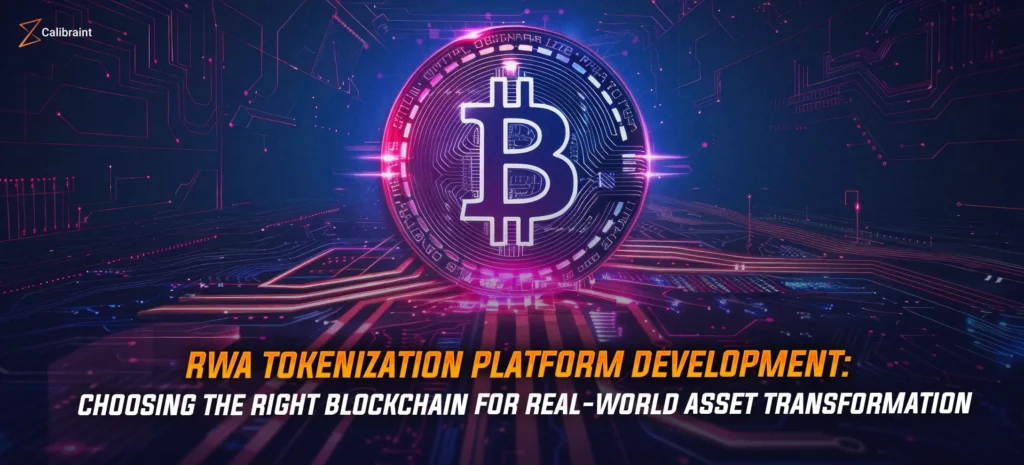RWA Tokenization Platform Development: Choosing the Right Blockchain for Real-World Asset Transformation
Calibraint
Author
July 21, 2025
Last updated: November 14, 2025

Introduction
RWA Tokenization Platform Development is transforming how traditional assets like real estate, commodities, debt instruments, and fine art are accessed and traded. By leveraging blockchain technology, businesses can fractionalize ownership of illiquid assets and offer global market access with higher liquidity, transparency, and compliance.
As global financial markets shift towards asset digitization, the infrastructure behind these tokenization platforms becomes increasingly vital. This is where selecting the right blockchain for RWA Tokenization Platform Development plays a pivotal role. From regulatory support to interoperability and scalability, multiple factors impact the success of an RWA platform.
This article provides an expert-curated overview of the most robust blockchains currently supporting RWA tokenization and highlights key considerations for building a reliable and regulation-ready platform.
Why RWA Tokenization Matters Today
The demand for tokenizing real-world assets has accelerated as investors look to diversify portfolios with tangible assets and businesses aim to unlock capital. Tokenization provides:
- Liquidity for traditionally illiquid assets
- 24/7 global market access
- Lower entry barriers for fractional investors
- Real-time settlement and ownership tracking
But the key to delivering these benefits lies in the infrastructure, namely, a powerful, secure, and compliant blockchain for RWA tokenization platform development.
Key Considerations for RWA Tokenization Platform Development
Before selecting a blockchain or initiating development, businesses must align their strategy with specific needs such as:
- Regulatory Compliance: Especially when dealing with securities, KYC/AML, and jurisdiction-specific requirements.
- Interoperability: Seamless integration with other financial systems and DeFi protocols.
- Scalability: To handle large volumes of tokenized transactions.
- Security: To safeguard digital and physical asset ownership.
- Smart Contract Capabilities: For automating compliance, payments, and governance.
Choosing a blockchain that fulfills these requirements determines how successful the RWA platform development will be in meeting market and investor expectations.
Top Blockchains for RWA Tokenization Platform Development
Here’s a carefully vetted list of the most relevant blockchains currently enabling RWA tokenization:
1. Ethereum
Why it works: As the most mature smart contract platform, Ethereum offers deep developer support and wide DeFi integration. Many RWA tokenization projects started on Ethereum.
Pros:
- Strong ecosystem
- High security
- Robust token standards (ERC-20, ERC-721, ERC-1155)
Cons:
- High gas fees
- Limited scalability (though mitigated by Layer 2s)
2. Polygon
Why it works: Built as a Layer 2 scaling solution for Ethereum, Polygon enhances throughput and reduces transaction costs while maintaining Ethereum compatibility.
Pros:
- Low fees
- EVM compatibility
- Developer-friendly
Use Case: Real estate tokenization platforms with frequent microtransactions benefit greatly from Polygon’s efficiency.
3. Avalanche
Why it works: Its Subnet architecture allows enterprises to build application-specific blockchains with customizable compliance settings.
Pros:
- High performance (4500+ TPS)
- Customizable subnets
- Institutional-grade tooling
Ideal For: Enterprises that require high throughput and regulatory control.
4. Stellar
Why it works: Focused on cross-border payments and asset issuance, Stellar is widely adopted for tokenizing fiat-backed assets and bonds.
Pros:
- Fast settlements
- Low transaction costs
- Strong focus on compliance
Popular With: Fintechs and banks digitizing traditional financial instruments.
5. Tezos
Why it works: Its on-chain governance and self-amending protocol make Tezos ideal for long-term RWA strategies.
Pros:
- Formal verification for smart contracts
- Eco-friendly PoS mechanism
Best Suited For: Legal and high-assurance environments, such as art and luxury collectibles tokenization.
6. Polkadot
Why it works: Designed for interoperability, Polkadot enables seamless asset transfer across multiple chains.
Pros:
- Parachain architecture
- Customizable governance
Use Case: Multi-chain RWA tokenization with DeFi protocol interactions.
7. Hyperledger Fabric
Why it works: Ideal for permissioned RWA tokenization platform development involving private consortia.
Pros:
- Permissioned access
- Fine-grained control over identity and roles
Popular For: Enterprises with strict data confidentiality needs.
8. Corda
Why it works: Focuses on legal clarity, traceability, and interoperability with legacy systems.
Pros:
- Enterprise-first approach
- Excellent auditability
Use Case: Tokenization of debt instruments and syndicated loans.
9. Algorand
Why it works: Offers low-latency finality and built-in Layer-1 asset tokenization features.
Pros:
- High throughput
- Minimal fees
Adopted By: Governments and institutions launching tokenized green bonds and fiat currencies.
10. Hedera Hashgraph
Why it works: Utilizes a unique consensus mechanism offering fairness, speed, and predictable fees.
Pros:
- Asynchronous Byzantine Fault Tolerance
- Council-governed structure
Ideal For: Platforms prioritizing low, fixed costs with high transparency.
How to Choose the Right Blockchain for RWA Tokenization Platform Development
Choosing a blockchain for RWA tokenization platform development isn’t about selecting the most popular one, it’s about matching platform needs to blockchain capabilities. Here’s a quick guide:
- Choose Ethereum or Polygon for DeFi-native assets.
- Go for Hyperledger or Corda when privacy and regulatory requirements are critical.
- Consider Avalanche or Algorand for high scalability and government-level deployments.
- Opt for Tezos or Stellar for tokenizing niche assets like art or cross-border financial products.
In all cases, compliance must be baked into the architecture from day one.
Conclusion
The rise of RWA tokenization is reshaping the financial industry, unlocking new liquidity pools, democratizing access, and making asset ownership borderless. At the heart of this transformation lies the RWA Tokenization Platform Development process where architecture, blockchain selection, and compliance converge.
A reliable and scalable blockchain for RWA tokenization platform development ensures the platform’s ability to evolve with market needs, investor confidence, and regulatory clarity.
As enterprises continue their push towards tokenizing physical and financial assets, understanding the foundational layers of RWA platform development will be key to long-term success.
Looking To Build a RWA Platform?
Partner with a blockchain development company that understands both the technical and regulatory depth of the RWA ecosystem. Choosing the right blockchain is just the beginning. The true value lies in seamless integration, compliance assurance, and a secure, investor-ready experience.
Calibraint
Author
July 21, 2025
Last updated: November 14, 2025
























